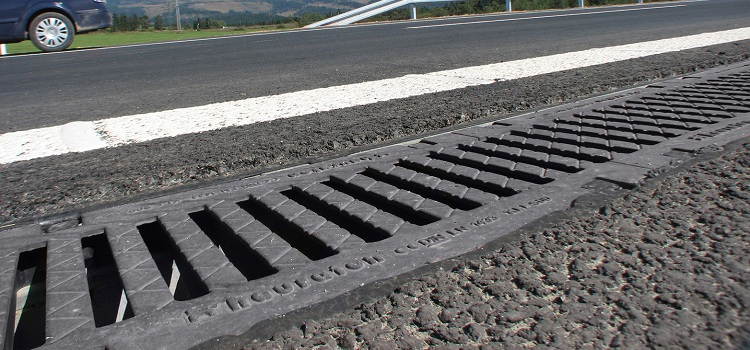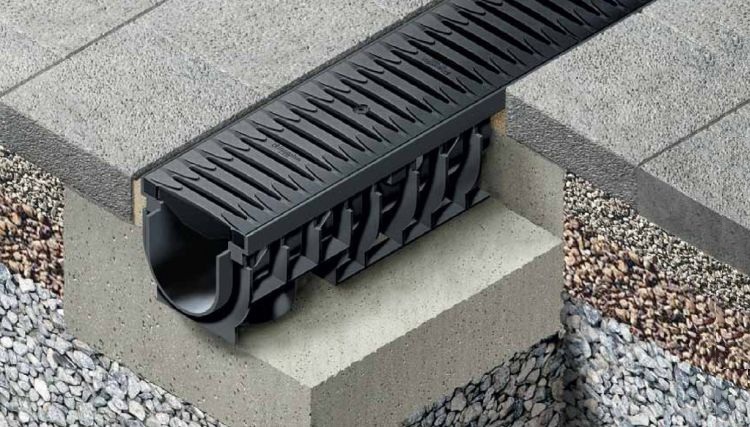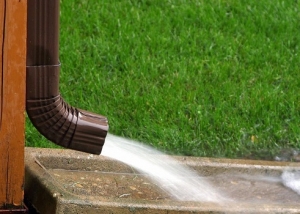Plastic drainage trays are structural elements that are used when laying drainage systems. Compared to concrete products, plastic analogues have many advantages. Drainage constructions made of plastic trays are used in areas with low or medium traffic intensity. The main advantage of these products is smooth internal walls, which affect good communication throughput.

Drainage channels on roads and other facilities are built on the basis of special trays that are laid in the ground
Content
Benefits of Drainage Plastic Trays
Consider the main advantages of plastic gutters in front of parts that are made of other materials:
- light weight. Plastic parts are lightweight, which simplifies their transportation and installation. They, as a rule, are 30-60 times lighter than concrete analogues;
- ease of installation. Polymeric products for drainage communications are characterized by ease of laying and a high rate of tightness of the joints. Installation can be carried out alone without the use of special equipment;
Note! Today, companies engaged in the production of drainage trays, produce products that have the ability to side dock, as well as parts with special connecting elements - pipes.
- if desired, polymer models can be shortened to obtain the required size;
- long service life. Plastic, which is used for the manufacture of structural elements of drainage systems, has increased resistance to mechanical stress and other positive properties. The operational life of such products can reach 50 years under normal use.;
- increased strength characteristics;
- good resistance to ultraviolet radiation;
- high resistance to temperature differences. The temperature range for such products ranges from −40 to +95 ° C;
- among other things, polymer products are resistant to the harmful effects of corrosion and aggressive chemical compounds. Due to this, they can be used to drain melt and rainwater, as well as other chemical compounds that enter trays during the operation of the roadway. Among these substances can be distinguished: acids, alkalis, various products released from vehicles, as well as chemicals that occur due to the processing of roads in the winter;
- high throughput ratio. Due to the structure of polymeric materials, the walls of the trays have a low roughness index, which affects the rate of water disposal;
- universality;
- affordable cost.
The device trays for drainage
Today, domestic companies produce a wide range of plastic gutters, which differ in their geometric characteristics. This allows you to expand the operational area of these drainage products.In the manufacture of drainage trays, as a rule, high-strength polymers (for example, polypropylene) are used, which are resistant to low temperatures and ultraviolet rays.
Plastic gutters are classified according to two main indicators:
- passage width;
- bandwidth coefficient.
Throughput and width are indicated in the corresponding marking. Throughput should be indicated taking into account the necessary slope of the drainage structure, which is often 0.5% -1.0%.
From a structural point of view, these products are gutters equipped with protective grids. Lattices protect the channels from clogging with foreign elements. They do not pass various large garbage (branches, stones, etc.). In addition, the auxiliary function of the grill is to give the product a presentable appearance. In most cases, trays are equipped with auxiliary fittings.
There is one important rule: the greater the width of the tray, the more it can let liquids per unit of time. To select a size, it is recommended to calculate the average rainfall per month and increase the figure by a quarter. The choice of these drainage elements also depends on the location of the installation. This is an important parameter, as it determines the load that will affect polymer drainage.
Important! The load can easily be determined by marking on the surface of the gutter. Depending on the ability of the trays to carry one load or another, they are all divided into classes, which are denoted by the letters A – E. The load indicator can be 1.5-60 tons.
As mentioned above, plastic drainage trays are used in areas with low or medium traffic intensity. Consider in which cases it is customary to use polymer gutters:
- courtyards in private homes;
- to drain melt and rainwater from garages;
- in park areas located underground;
- walking paths;
- bike lanes;
- on the roofs of various structures.
Drain pan sizes
Road communications differ in that they can be mounted from various structural elements. Plastic trays for drainage differ in their geometric parameters, which include not only dimensions, but also shape. The advantage of polymer products is that they have a wide variety of sizes.
Depending on the bandwidth of the channel, their bandwidth is determined. This indicator can be 140-500 mm. Due to this diversity, it becomes possible to lay a drainage system that can remove a large amount of precipitation and melt water without the need for a deep channel.
All water trays are classified by the load that they can withstand. Depending on the operational load, several classes of drainage trenches are distinguished. They are indicated in the table.
Table 1
| Class designation | Load, t | Operational area |
| A15 | 1,5 | walking paths; bike lanes. |
| B125 | 12,5 | parking areas for cars; garages for cars. |
| C250 | 25 | pedestrian walkways; car service workshops. |
| D400 | 40 | roadsides; gas stations; objects of transport infrastructure with low traffic density. |
| E600 | 60 | Industrial enterprises; berths; warehouses; highways; objects of transport infrastructure with high traffic density. |
Another important indicator is the height of the tray. As a rule, this parameter does not exceed the mark of 800 mm. Trays with a height that exceeds 120 mm are used extremely rarely.For the organization of drainage in private economic cases, products with a height of 60 to 120 mm are used. The radius (completed around the circumference) of these structural elements for drainage in most cases is 100 mm.
Drainage trays can have a weight of 9 to 14 kg. This is a very small figure if we compare their weight with that of concrete trays or gutters of other materials.
Varieties of tray grids
Drainage trays road without fail are equipped with special protective lattices. Lattices protect the channel from various large debris that can cause clogging of the system. All grates for drainage polymer trays are classified according to several parameters. Consider these options:
- load class;
- material of manufacture;
- appearance.
The load class of plastic drainage elements and their grids determines the operational area. Depending on the class of load, you can choose the necessary grate.
Grids for gutters are made of the following materials:
- plastic;
- cast iron;
- steel.
Today you can find the most diverse in appearance gratings. This parameter includes two main components:
- design;
- Colour.
In turn, the design of these grids suggests the following structure:
- cellular;
- crevice;
- wavy.
The most popular colors of drainage gratings:
- black;
- steel.
Many manufacturers carry out individual orders of gratings, which can have any shape and color.
Polymer composite gutters
Drainage composite trays are produced by mixing various materials. Production of drainage trays is carried out using the following materials:
- a mixture of concrete mortar with polymeric material;
- a mixture of sand with polymeric materials and other auxiliary additives.
The main advantage of these drainage trenches is that a mixture of polymer material with concrete or sand can significantly increase their strength characteristics. According to other indicators, these products are not inferior to their plastic counterparts.
Note! The only significant drawback of these products is their low resistance to mechanical shock.
The drainage composite tray consists of a direct chute and a protective grill. In addition, such elements are lightweight, which allows them to be mounted much faster than concrete counterparts.










